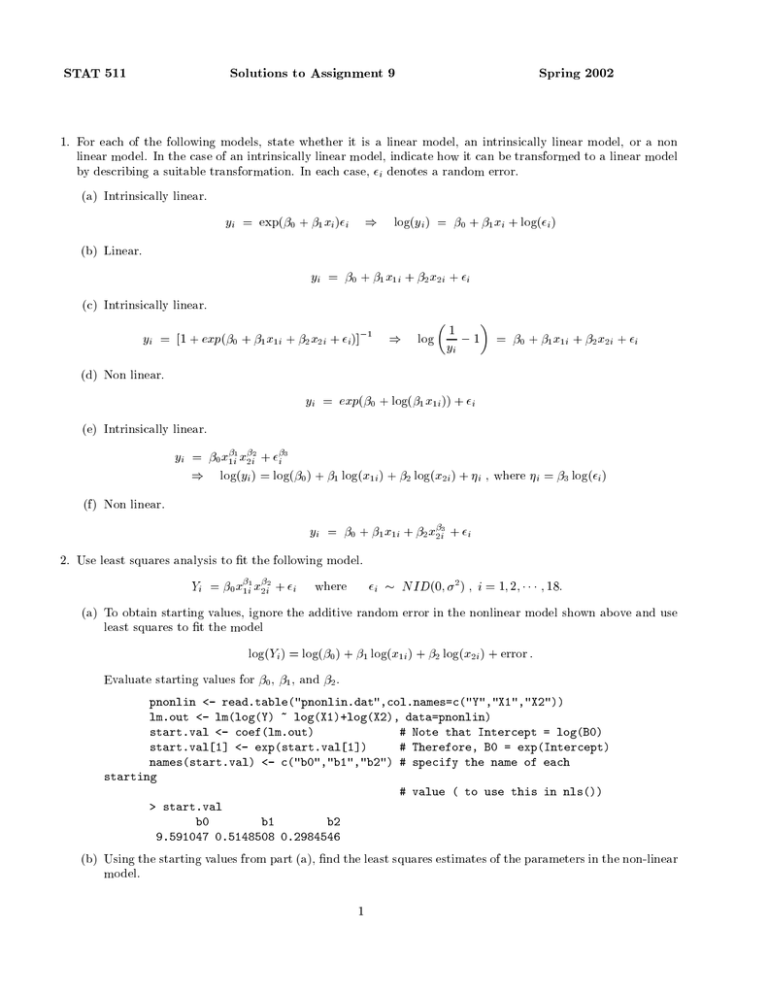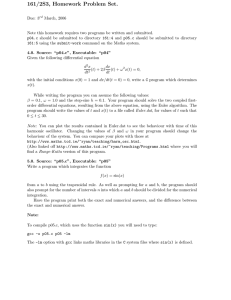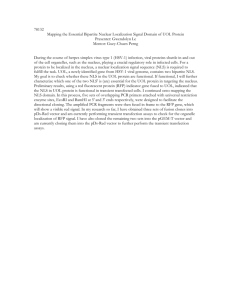ST A T 511
advertisement

STAT 511
Solutions to Assignment 9
Spring 2002
1. For each of the following models, state whether it is a linear model, an intrinsically linear model, or a non
linear model. In the case of an intrinsically linear model, indicate how it can be transformed to a linear model
by describing a suitable transformation. In each case, i denotes a random error.
(a) Intrinsically linear.
)
yi = exp(0 + 1 xi )i
log(yi ) = 0 + 1 xi + log(i )
(b) Linear.
yi = 0 + 1 x1i + 2 x2i + i
(c) Intrinsically linear.
yi = [1 + exp(0 + 1 x1i + 2 x2i + i )]
1
)
log
1
yi
1
= 0 + 1 x1i + 2 x2i + i
(d) Non linear.
yi = exp(0 + log(1 x1i )) + i
(e) Intrinsically linear.
yi = 0 x1i1 x2i2 + i 3
) log(yi ) = log(0 ) + 1 log(x1i ) + 2 log(x2i ) + i , where i = 3 log(i )
(f) Non linear.
yi = 0 + 1 x1i + 2 x2i3 + i
2. Use least squares analysis to t the following model.
Yi = 0 x1i1 x2i2 + i
i
where
NID(0; 2 ) ; i = 1; 2; ; 18:
(a) To obtain starting values, ignore the additive random error in the nonlinear model shown above and use
least squares to t the model
log(Yi ) = log(0 ) + 1 log(x1i ) + 2 log(x2i ) + error :
Evaluate starting values for 0 , 1 , and 2 .
pnonlin <- read.table("pnonlin.dat",col.names=c("Y","X1","X2"))
lm.out <- lm(log(Y) ~ log(X1)+log(X2), data=pnonlin)
start.val <- coef(lm.out)
# Note that Intercept = log(B0)
start.val[1] <- exp(start.val[1])
# Therefore, B0 = exp(Intercept)
names(start.val) <- c("b0","b1","b2") # specify the name of each
starting
# value ( to use this in nls())
> start.val
b0
b1
b2
9.591047 0.5148508 0.2984546
(b) Using the starting values from part (a), nd the least squares estimates of the parameters in the non-linear
model.
1
hw9.2.nls <- nls(formula
data
start
trace
> summary(hw9.2.nls)
=
=
=
=
Y ~ b0*(X1^b1)*(X2^b2),
pnonlin,
start.val,
T)
Formula: Y ~ b0 * (X1^b1) * (X2^b2)
Parameters:
Value
b0 10.079600
b1 0.498710
b2 0.301989
Std. Error
0.39817000
0.00780672
0.00485308
t value
25.3147
63.8821
62.2262
Residual standard error: 4.19081 on 15 degrees of freedom
) 0 = 10:1; 1 = 0:499;
and 2 = 0:302
0
100
200
Z
300
400
500
(c) Make a plot showing the observed data and the estimated surface for the mean yield. Does this model
appear to be adequate?
Yes. The following plots include a 3-dimensional plot of the estimated surface and prole plots that more
clearly show how close the observed responses are to the estimated surface.
10
0
80
100
60
80
Y
60
40
40
20
20
0
2
0
X
500
HW6 2.(c)
300
200
0
100
Fitted Value
400
X2 = 1
X2 = 10
X2 = 100
0
20
40
60
80
100
80
100
X1
500
HW6 2.(c)
300
200
100
0
Fitted Value
400
X1 = 1
X1 = 10
X1 = 100
0
20
40
60
X2
3
(d) Plot the residuals against the values of x1 and x2 , on seperate plots. What do these plots indicate?
The plots do not reveal any serious departures from the assumption of homogeneous error variances. The
plot of the residuals against x2 suggests that there may be some eect of x2 , in the lower range of values,
that is not fully described by the model.
Residuals against X1
6
•
•
4
•
•
•
0
•
-2
•
•
•
•
•
•
-4
Residuals
2
•
•
-6
•
•
-8
•
0
20
40
60
X1
6
Residuals against X2
•
•
4
•
•
2
•
0
•
-2
Residuals
•
•
•
•
••
•
-4
••
-6
•
•
-8
•
0
20
40
60
80
100
X2
(e) Create a normal probability plot for the residuals. What does this plot suggest?
4
80
100
This plot suggests that an assumption of normally distributed errors may be a reasonable approximation.
The largest positive residual is somewhat closer to zero than expected.
Normal Probability Plot of Residuals
6
•
•
4
•
•
•
0
2
•
• •
•
-2
hw6.2.nls$res
•
•
•
• •
-4
•
-6
•
•
-8
•
-2
-1
0
1
2
Quantiles of Standard Normal
(f) Assume that the proposed non linear model is appropriate and use the large sample distributional properties of the least squares estimators to do the following.
(i) Construct 95% condence intervals for 0 , 1 , and 2 .
> # Approximate profile likelihood confidence intervals.
> rbind(b0 = confint.nls(hw9.2.nls,parm="b0"),
+
b1 = confint.nls(hw9.2.nls,parm="b1"),
+
b2 = confint.nls(hw9.2.nls,parm="b2")) # Lecture Note 11.15
[,1]
[,2]
b0 9.2548676 10.9461031
b1 0.4824410 0.5156617
b2 0.2917425 0.3124756
> # Compute confidence intervals for parameters using
> # standard large sample normal theory
> est.b(hw9.2.nls) # Lecture Note 11.16
b
stderr
low
high
b0 10.0795655 0.398169756 9.2308868 10.9282442
b1 0.4987098 0.007806722 0.4820702 0.5153495
b2 0.3019886 0.004853080 0.2916445 0.3123327
These two methods provide very similar condence intervals in this case.
(ii) Construct a 95% condence interval for the mean yield when x1 = 50 and x2 = 60.
# first partial derviatives of the mean function needed to
# apply the delta method
yield.pds <- deriv3(~ b0*x1^b1*x2^b2,
5
c("b0","b1","b2"), function(x1,x2, b0, b1, b2) NULL)
# Compute the estimates of the times and the large sample
# covariance matrix and standard errors
est.yield<- function(x1, x2, obj,level=.95)
{
b <- coef(obj)
tmp <- yield.pds(x1, x2, b["b0"], b["b1"], b["b2"])
y.hat <- as.vector(tmp)
G <- matrix(attr(tmp, "gradient"),nrow=1)
v <- (G %*% vcov(obj) %*% t(G))
n <- length(obj$fitted.values) - length(obj$parameters)
low <- y.hat - qt(1 - (1 - level)/2, n)*sqrt(v)
high <- y.hat + qt(1 - (1 - level)/2, n)*sqrt(v)
result <- c(y.hat = y.hat, std.err = sqrt(v), lower.bound=low,
upper.bound=high)
return(G.hat=G, V.hat= vcov(obj), S2 = v, result=result)
}
> est.yield(x1=50,x2=60, hw6.2.nls)
$G.hat:
<-- First partial derivatives of the estimated surface
at (X1,X2)=(50,60).
[,1]
[,2]
[,3]
[1,] 24.2256 955.2514 999.7713
$V.hat:
<-- covariance matrix for the parameter estimates.
b0
b1
b2
b0 0.1585391548 -2.675067e-03 -9.377983e-04
b1 -0.0026750667 6.094491e-05 1.503385e-13
b2 -0.0009377983 1.503385e-13 2.355238e-05
$S2:
<-- variance for the estimated mean velocity.
[,1]
[1,] 2.960183
$result:
y.hat std.err lower.bound upper.bound <-- Approximate 95%
Confidence Interval.
244.1835 1.720518
240.5163
247.8507
(iii) Test the null hypothesis H0 : 1 = 2 versus HA : 1 6= 2 . Indicate how your test was performed.
State your conclusion.
For any estimable function C b ,
Let C = [0 1
C b _ N(C b ; CVb C T ) :
1], then
b1
Therefore, under the null hypothesis,
b2 _ N(1
2 ; CVb C T ) :
b1 b2
_ tn p
C V^b C T
q
Reject H0 if j t j > tn p;=2 .
This can be computed with Splus as follows:
6
C <- matrix(c(0,1,-1),nrow=1)
b <- coef(hw9.2.nls)
V.Cb <- C %*% vcov(hw9.2.nls) %*% t(C)
t.stat <- (C %*% b) / sqrt(V.Cb)
df <- length(hw9.2.nls$fitted) - length(hw9.2.nls$par)
p.val <- 2*(1- pt(abs(t.stat),df))
result <- c(b1.minus.b2= C %*% b, std.err=sqrt(V.Cb),
t.stat=t.stat,df=df,p.val=p.val)
> result
b1-b2
std.err t.stat df
p.val
0.1967212 0.009192241 21.40079 15 1.180611e-12
Reject the null hypothesis H0 : 1 = 2 . 1 is signicantly dierent from 2 .
A second method uses an approximate F-test. From part (b), the sum of squared residuals for tting
the model
yi = 0 x1i1 x2i2 + i
is RSS1 = 263:4433. Fit the more restricted model
yi = 0 (x1i x2i )1 + i :
The residual sum of squares for this model is RSS2 = 9331:624. Compute an approximate F-test for
comparing the t of nested models.
(RSS2 RSS1 ) = 1
F =
= 516:3263 on (1,n-3) d.f.
RSS1 =(n 3)
Then p-value < 0.0001. 1 is signicantly dierent from 2 .
# Fit a restricted model, Y ~ a0 * (X1*X2)^a1, to calculate RSS.2
X1X2 <- pnonlin$X1 * pnonlin$X2
lm.out <- lm(log(pnonlin$Y) ~ log(X1X2))
start.val <- coef(lm.out)
# Note that Intercept = log(a0)
start.val[1] <- exp(start.val[1])
# Therefore, a0 =
exp(Intercept)
names(start.val) <- c("a0","a1")
# specify the name of each
starting
# value ( to use this in nls())
# Calculate F-statistics.
RSS.1 <- deviance(hw6.2.nls)
RSS.2 <- deviance(nls(formula = Y ~ a0*(X1*X2)^a1,start =
start.val,data=pnonlin))
df <- length(hw6.2.nls$fit) - length(hw6.2.nls$par)
F.stat <- (RSS.2-RSS.1)/(RSS.1/df)
p.val <- 1-pf(F.stat,1,df)
> c(RSS.1=RSS.1, RSS.2=RSS.2,NDF=1,DDF=
df,"F-value"=F.stat,"p-value"=p.val)
RSS.1
RSS.2 NDF DDF F-value
p-value
263.4433 9331.624 1 15 516.3263 4.92717e-13
3. In an enzyme kinetics study, the velocity of a reaction (y) is expected to be related to the concentration (x) of
a substance as follows:
yi =
0 xi
+
1 + xi i
7
(a) To obtain starting values, ignore that the additive error and note that
yi
1
1 + 1 xi 1 :
0
0
Use least squares regression analysis to obtain estimates of 0 1 and 1 =0 , and list your starting values
for 0 and 1 .
kinetics <- read.table("kinetics.dat",col.names=c("Y","X"))
YY <- 1/kinetics$Y
XX <- 1/kinetics$X
lm.out <- lm(YY ~ XX)
#lm.out <- lm(1/Y ~ 1/X, data=kinetics) # This is not right;
this fits
# 1/Y = a0 + a1*(X %in% 1)
# i.e. 1/Y = a0 + a1*X
start.val <- coef(lm.out)
start.val[1] <- 1/start.val[1]
1/Intercept
start.val[2] <- start.val[1]*start.val[2]
names(start.val) <- c("b0","b1")
each starting
nls())
start.val
b0
b1
29.62201 13.44881
# Note that Intercept = 1/b0
# Therefore, b0 =
# b1 = b0 * (b1/b0)
# specify the name of
# value ( to use this in
<--- starting values
(b) Using the starting values from part (a), nd the least squares estimates of 0 and 1 in the orginal
non-linear model.
hw9.3.nls <- nls(formula
data
start
trace
=
=
=
=
Y ~ b0*X/(b1+X),
kinetics,
start.val,
T)
> summary(hw9.3.nls)
Formula: Y ~ (b0 * X)/(b1 + X)
Parameters:
Value Std. Error t value
b0 28.1379 0.728023 38.6497
b1 12.5753 0.763112 16.4790
Residual standard error: 0.518548 on 16 degrees of freedom
) 0 = 28:1
8
and
1 = 12:6
(c) Make a plot showing the estimated velocity and the observed data. Does the model appear to be adequate?
Yes.
15
10
0
5
Fitted Value & Obs.
20
25
HW6 3.(c)
0
10
20
30
40
X
(d) Plot the residuals against the concentration(x). What does this plot suggest?
There is no obvious trend in these residuals to suggest that the model is not adequate. There is no evidence
to refute the assumption of homogeneous error variances across values of x1 .
9
Residuals against X
1.0
•
0.5
•
•
•
•
•
•
•
0.0
Residuals
•
• •
•
•
-0.5
•
•
•
•
-1.0
•
0
10
20
30
40
X
(e) Create a normal probability plot for the residuals. What does this plot suggest?
An assumption of normally distributed random errors seems to be reasonable.
Normal Probability Plot of Residuals
1.0
•
0.5
•
•
•
• •
•
• • •
0.0
hw6.3.nls$res
•
• •
-0.5
•
•
•
•
-1.0
•
-2
-1
0
Quantiles of Standard Normal
(f) Construct 95% condence intervals for 0 and 1 .
10
1
2
> rbind(b0 = confint.nls(hw6.3.nls,parm="b0"),
+
b1 = confint.nls(hw6.3.nls,parm="b1")) # Lecture Note 11.15
[,1]
[,2]
b0 26.64508 29.79735
b1 11.03554 14.35170
> est.b(hw6.3.nls) # Lecture Note 11.16
b
stderr
low
high
b0 28.13786 0.7280235 26.59452 29.68120
b1 12.57534 0.7631121 10.95762 14.19307
(g) Estimate the concentration (x) at which the expected velocity of the reaction is 25. Report a 95%
condence interval for the concentration.
1 1 1
1 = 0 1
yi 1 =
+ x : ) xi =
1
1
0 0 i
1
0 yi
0
yi
# first partial derviatives of the mean function needed to
# apply the delta method
x.pds <- deriv(~ b1/(b0/y -1),
c("b0","b1"), function(y, b0, b1) NULL)
# Compute the estimates of the times and the large sample
# covariance matrix and standard errors
est.x <- function(y, obj,level=.95)
{
b <- coef(obj)
tmp <- x.pds(y, b["b0"], b["b1"])
x.hat <- as.vector(tmp)
G <- matrix(attr(tmp, "gradient"),nrow=1)
v <- (G %*% vcov(obj) %*% t(G))
n <- length(obj$fitted.values) - length(obj$parameters)
low <- x.hat - qt(1 - (1 - level)/2, n)*sqrt(v)
high <- x.hat + qt(1 - (1 - level)/2, n)*sqrt(v)
result <- c(x.hat = x.hat, std.err = sqrt(v), lower.bound=low,
upper.bound=high)
return(G.hat=G, V.hat= vcov(obj), S2 = v, result=result)
}
> est.x(y=25, hw6.3.nls)
$G.hat:
[,1]
[,2]
[1,] -31.94452 7.969379
$V.hat:
b0
b1
b0 0.5299500 0.5202788
b1 0.5202788 0.5822457
$S2:
[,1]
[1,] 312.8647
$result:
11
x.hat std.err lower.bound upper.bound
100.2102 17.68798
62.71335
137.707
4. The bootstrap provides a reasonably good estimator for the standard error of the sample median, as well as a
condence interval for the median, without any knowledge of the c.d.f. F (x). Basically, the bootstrap replaces
the derivation of asymptotic theoretical results with simulation.
(a) Compute the sample median of the survival times. Use bootstrap methods to obtain a standard error for
the sample median and 95% percentile condence limits for the population median. Also compute bias
corrected accelerated 95% condence limits. (Use 1,000 bootstrap samples.)
heart1 <- c(scan("heart1.dat")) # read the data
nboot <- 1000
# size of bootstrap samples
> median(heart1) # sample median
[1] 207
m.boot1 <- bootstrap(heart1, nboot=nboot, theta=median)$thetastar
0.0
0.002
0.004
0.006
0.008
0.010
0.012
1000 bootstrap sample median (heart1.dat)
100
200
300
400
500
m.boot1
> sqrt(var(m.boot1)) # standard error for the sample median
[1] 68.78402
# construct 95% percentile confidence limits for the population median
m.boot1 <-sort(m.boot1)
alpha <- .05
kl <- floor((nboot+1)*alpha/2)
ku <- nboot+1 - kl
mlower <- round(m.boot1[kl],digits=4)
mupper <- round(m.boot1[ku],digits=4)
> c(kl,ku)
[1] 25 976
> c("Lower Limit"=mlower, "Upper Limit"=mupper)
Lower Limit Upper Limit
109
342
12
bca.interval <- bcanon(x=heart1,nboot=nboot,theta=median,alpha=c(.025,.975))
> bca.interval$confpoints
alpha bca point
[1,] 0.025
100
[2,] 0.975
340
(b) Repeat part(a) for the survival times for a similar set of 34 patients that did not receive heart transplants.
heart2 <- c(scan("heart2.dat")) # read the data
> median(heart2) # sample median
[1] 21
m.boot2 <- bootstrap(heart2, nboot=nboot, theta=median)$thetastar
0.0
0.02
0.04
0.06
1000 bootstrap sample median (heart2.dat)
10
20
30
40
50
60
70
m.boot2
> sqrt(var(m.boot2)) # standard error for the sample median
[1] 8.396851
# construct 95% percentile confidence limits for the population median
m.boot2 <-sort(m.boot2)
mlower <- round(m.boot2[kl],digits=4)
mupper <- round(m.boot2[ku],digits=4)
> c("Lower Limit"=mlower, "Upper Limit"=mupper)
Lower Limit Upper Limit
9
37
# Compute the bias corrected accelerated intervals
bca.interval <- bcanon(x=heart2,nboot=nboot,theta=median,alpha=c(.025,.975))
13
> bca.interval$acc
[1] NA
> bca.interval$confpoints
alpha bca point
[1,] 0.025
NA
[2,] 0.975
NA
The BCA condence interval method does not work in part (b) of problem 1. This happens because the
accelation constant(^a) cannot be computed. This is a feature of the data (and the sample median). Note
that the two middle values in this data set are both 21. When the program uses a jackknife method (leave
one case at a time out of the data set and compute the statistic (sample median) with the remaining n-1
cases) it always gets a value of 21 for the resulting sample median. Hence, the sum of squares in the
denominator of the formula for the accelaration constant is zero (so is the numerator) and the algorithm
refuses to divide by zero and records the value of the accelaration constant as "NA" (to indicate a missing
value). The BCA condence intervals do not seem to be a very good idea for creating a condence interval
for a median.
14
(c) Use bootstrap methods to test the null hypothesis that the median survival time for patients that received
heart transplants is equal to the median survival time for similar patients that do not receive heart
transplants. Describe your procedure and state your conclusion.
(1) take independnt bootstrap samples from the heart1 and heart2 data les and calculate sample medians.
Call these bootstrapped medians 1;b and 2;b .
(2) calculate di,b = 1;b 2;b .
(3) repeat steps (1) { (2) B times. (e.g. B = 1000)
(4) order the bootstrapped values from smallest to largest.
di,(1) ; di,(2) ; ; di,(B) ;
(5) An approximate (1
is
)% condence interval for di (the dierence between median survival times)
di,(KL) ; di,(KU )
diff.boot <- m.boot1 - m.boot2
diff.boot <- sort(diff.boot)
diff.lower <- round(diff.boot[kl],digits=4)
diff.upper <- round(diff.boot[ku],digits=4)
> c("Lower Limit"=diff.lower, "Upper Limit"=diff.upper)
Lower Limit Upper Limit
91.5
305
The approximate 95% condence interval does not contain 0. The median survival time for patients that
received heart transplants is signicantly greater than the median survival time for patients that did not
receive heart transplants.
5. Consider the model you t to the chemical process data in Problem 2.
yi = 0 x1i1 x2i2 + i
where i NID(0; 2 ) ; i = 1; 2; ; 18:
(a) Use bootstrap methods to solve Part (f) of that problem, i.e. construct condence intervals for the
parameters.
pnonlin <- read.table("HW9/pnonlin.dat",col.names=c("Y","X1","X2"))
# Use the residuals from the Splus object created
# with the S-plus code for problem 2
s2 <- sum(resid(hw9.2.nls)^2)/(18-3)
centered.res <- scale(resid(hw9.2.nls),center=T,scale=F)
rescaled.res <- centered.res * sqrt(s2/var(c(centered.res)))
# Now, sum of centered.res and rescaled.res is zero.
round( c(sum(resid(hw9.2.nls)), sum(centered.res), sum(rescaled.res)), 6 )
# variance of rescaled.res is equal to the variance estimate of the model.
c(s2, var(centered.res), var(rescaled.res) )
# define a function to calculate b0,b1,b2 and y.hat for each replicate.
hw9.5.boot.f1 <- function( id, x1=100, x2=50 ){
newdata <data.frame(Y=pnonlin$Y[id],X1=pnonlin$X1[id],X2=pnonlin$X2[id])
nls.out <- nls(formula = Y ~ b0*(X1^b1)*(X2^b2),
15
data = newdata, start = coef(hw9.2.nls))
beta0 <- coef(nls.out)[1]
beta1 <- coef(nls.out)[2]
beta2 <- coef(nls.out)[3]
y.hat <- beta0*(x1^beta1)*(x2^beta2)
return(c(beta0=beta0,beta1=beta1,beta2=beta2,y.hat=y.hat))
}
hw9.5.boot.f2 <- function( resids, x1=100, x2=50 ){
assign("new.Y", fitted(hw9.2.nls)+resids, frame=1)
nls.out <- nls(formula = new.Y ~ b0*(X1^b1)*(X2^b2),
data = pnonlin, start = coef(hw9.2.nls))
beta0 <- coef(nls.out)[1]
beta1 <- coef(nls.out)[2]
beta2 <- coef(nls.out)[3]
y.hat <- beta0*(x1^beta1)*(x2^beta2)
return(c(beta0=beta0,beta1=beta1,beta2=beta2,y.hat=y.hat))
}
# bootstrapping
# (a)-i Resample cases with replacement
hw9.5.boot1 <- bootstrap(data=1:nrow(pnonlin), B=1000,
statistic=hw9.5.boot.f1 )
hw9.5.boot2 <- bootstrap(data=centered.res,B=1000,statistic=hw9.5.boot.f2)
hw9.5.boot3 <- bootstrap(data=rescaled.res,B=1000,statistic=hw9.5.boot.f2)
names(hw9.5.boot1)
dim(hw9.5.boot1$replicates) # 1000 x 4 matrix
# Each row of hw9.5.boot$replicates contains 1000 bootstrap samples
# for b0,b1,b2 and y.hat respectively.
get.bootconfint <- function( bootobj, alpha=.05 ){
nboot <- bootobj$B
boot.b0 <- sort(bootobj$replicates[,1]) # B bootstrap samples for b0
boot.b1 <- sort(bootobj$replicates[,2]) # B bootstrap samples for b1
boot.b2 <- sort(bootobj$replicates[,3]) # B bootstrap samples for b2
boot.yhat <- sort(bootobj$replicates[,4]) # B bootstrap samples for y.hat
kl <- floor((nboot+1)*alpha/2)
ku <- nboot+1 - kl
result <- rbind( c("Lower Limit"=boot.b0[kl],"Upper Limit"=boot.b0[ku]),
c("Lower Limit"=boot.b1[kl],"Upper Limit"=boot.b1[ku]),
c("Lower Limit"=boot.b2[kl],"Upper Limit"=boot.b2[ku]),
c("Lower Limit"=boot.yhat[kl],"Upper
Limit"=boot.yhat[ku]))
row.names(result)<- c("b0","b1","b2","y.hat")
result
}
> get.bootconfint( bootobj=hw9.5.boot1 ) #(i)
Lower.Limit Upper.Limit
b0 8.8612263 10.7739221
b1 0.4857380 0.5263606
b2 0.2934535 0.3196113
y.hat 322.2808683 339.5373815
> get.bootconfint( bootobj=hw9.5.boot2 ) #(ii)
Lower.Limit Upper.Limit
b0 9.3812374 10.7308708
16
b1 0.4855504 0.5128529
b2 0.2935353 0.3104085
y.hat 322.8196396 330.1081198
> get.bootconfint( bootobj=hw9.5.boot3 ) #(iii)
Lower.Limit Upper.Limit
b0 9.3250777 10.8731550
b1 0.4838211 0.5139061
b2 0.2930917 0.3110945
y.hat 322.3038933 330.3749005
(b) Construct a 95% condence interval for the expected yield of the process when x1 = 100 and x2 = 50.
(c) Construct an approximate 95% prediction interval for the realization of the yield when x1 = 100 and
x2 = 50.
Large sample normal condence interval and prediction interval for for the realization of the yield when
x1 = 100 and x2 = 50 are computed as follows.
confint.5b <- est.yield(x1=100,x2=50, obj=hw9.2.nls)[[4]]
yhat <- confint.5b["y.hat"]
pred.err <- sqrt(confint.5b["std.err"]^2+s2) # add mse to the std error
predint.5c <- c( yhat, pred.err,
yhat - qt(1-.05/2, n)* pred.err,
yhat + qt(1-.05/2, n)* pred.err )
result <- rbind( confint.5b, predint.5c )
dimnames(result) <- list( c("5(b):conf.int", "5(c):pred.int"),
c("y.hat","std.err","lower.bound","upper.bound") )
> result
y.hat std.err lower.bound upper.bound
5(b):conf.int 326.536 2.092765
322.0754
330.9966
5(c):pred.int 326.536 4.684288
316.6947
336.3773
Bootstrap prediction intervals using centered and centered and rescaled residuals are given below.
n <- nrow(pnonlin)
nboot <- length(length(hw9.5.boot2$replicates[,4]))
pred.boot2 <- hw9.5.boot2$replicates[,4] +
centered.res[sample(n, size=nboot, replace=T)]
pred.boot3 <- hw9.5.boot3$replicates[,4] +
rescaled.res[sample(n, size=nboot, replace=T)]
> rbind( quantile( pred.boot2, c(.0, .025, .5, .975, 1) ),
+
quantile( pred.boot3, c(.0, .025, .5, .975, 1) ) )
0.0%
2.5%
50.0%
97.5% 100.0%
[1,] 322.3229 325.1030 328.7789 332.2324 334.0550
[2,] 317.9855 320.3341 324.7133 328.3916 330.0262
Note that it would be better to studentize the residuals before they are rescaled in the manner shown
above, but it may not change the results very much.
Compare the bootstrap intervals to the large sample normal intervals.
Comparisons (95% confidence intervals)
--------------------------------------
17
b0
b1
b2
yhat
Large Sample
Normal approx.
Bootstrap
Lower
9.2
0.482
0.292
322.1
Lower
9.4
0.485
0.293
322.8
Upper
10.9
0.515
0.312
330.4
Upper
10.8
0.514
0.310
330.1
As in the analysis of the stormer data given in the lectures, and in Venables and Ripley, the bootstrap condence
intervals tend to be shorter than condence intervals based on the large sample normal approximation to the
distribution of the parameter estimates. This occurs because residuals exhibit less variation than the actual
random errors.
18








